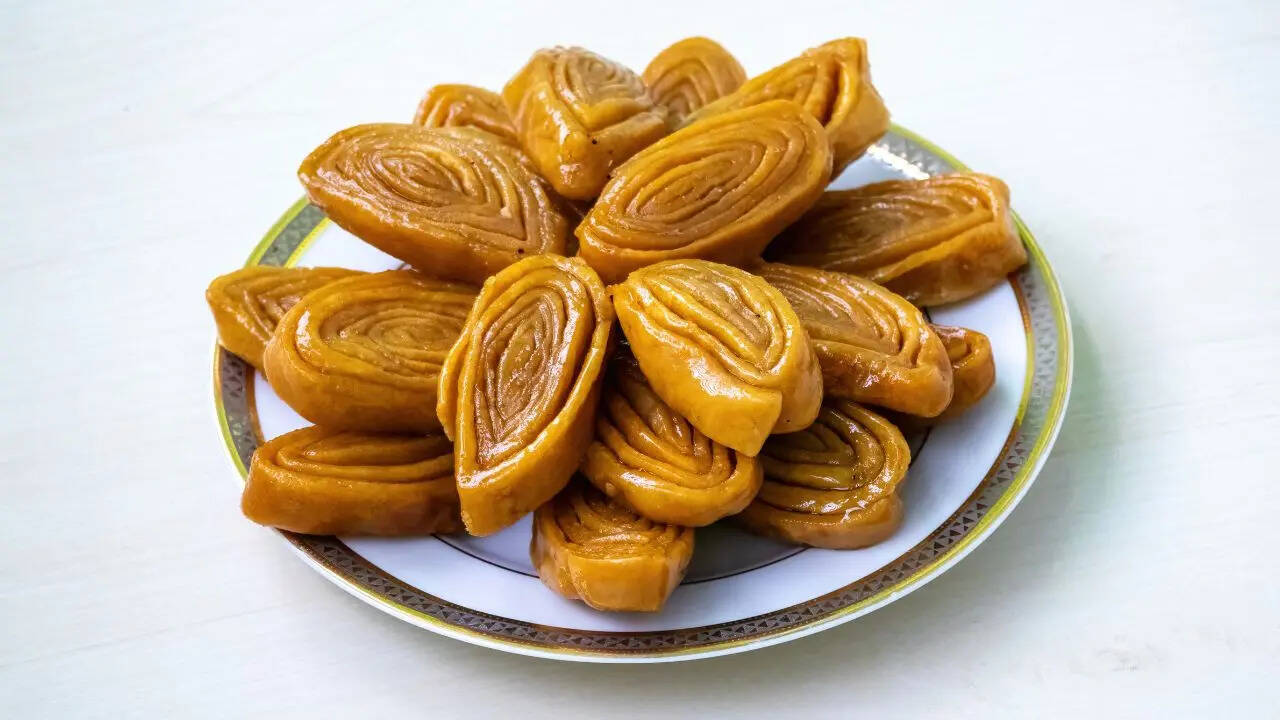There’s something unmistakably charming about an Indian sweet that’s not just loaded with layers of pastry and syrup but also drenched in stories older than most civilisations. Enter khaja — the flaky, syrupy treat you’re likely to spot in temple prasad thalis, roadside stalls, and foodie bucket lists alike. A darling of Lord Jagannath and a must-buy from Puri’s Grand Road, khaja may appear humble, but its history is anything but. From being dubbed “food for power sustenance” by Chanakya to reportedly delighting Gautam Buddha and making a GI-tagged home in Silao, Bihar, this ancient mithai is steeped in tales that whisk you across dynasties, deities, and desserts. So what exactly ties the sacred town of Puri to Nalanda’s intellectual past? As it turns out — a pastry, not a person. From Silao with Crunch: The Mauryan Sweetmeat Let’s rewind to 320 BCE, when the Mauryan Empire was in full swing and the world was discovering the joys of gastronomy with the same fervour as war strategies. According to some food historians, the earliest version of khaja was born in Silao, a sleepy village nestled between Mithila and Nalanda in modern-day Bihar. Here, wheat was in abundance and sweets weren’t just indulgent — they were symbolic. Legend has it that Chanakya, the ancient economist and strategist, mentioned this sweet in the Arthashastra, calling it ideal for “power sustenance.” That’s right — khaja was once warrior food. Even the Chinese monk Hiuen Tsang, known for his culinary curiosity, noted khaja’s resemblance to baklava during his travels to Mithila. And a local tale claims that Gautam Buddha, while journeying through Rajgir, was so charmed by the treat that he offered it to his disciples. Today, Silao Khaja enjoys GI tag status, thanks to the research of archaeologist JD Beglar, who traced its popularity back to the era of King Vikramaditya in the 19th century. Unlike its syrup-soaked cousin from Puri, Silao khaja is drier, crispier, and, as they say in the mithai world, perfect for travel. South India’s Sticky Contribution: Khajas with a Twist Venture down south, and you’ll find gottamkhajas and madathakhajas—sweeter, gooier, and thicker cousins of the Northern variety. Hailing from coastal Andhra Pradesh, these versions rely on dense ribbons of wheat pastry. While madathakhajas remain dry and roll out in neat cylinders, gottamkhajas ooze sugar syrup from their cores. Interestingly, a 12th-century Sanskrit treatise named Mānasollāsa (also known as Abhilashitartha Chintamani) mentions a delicacy called khajjaka, gifted to royalty and laced with cardamom and clove. In essence, khaja may have once doubled as a royal bribe in the kitchens of the Chola kings. Khaja’s Temple Transformation: A Sweet Entry to the Divine Fast forward to the 12th century — khaja officially becomes a spiritual celebrity. By this time, the flaky pastry had made its way east and become an integral part of the Chhappan Bhog (56 offerings) at the Jagannath Temple in Puri. However, the version served here underwent a glorious makeover. The pastry dough, once purely wheat-based, now included maida (refined flour) for elasticity, making the layers thinner and more pronounced. Food historian Minati Parhi explains that this change improved syrup absorption, which back then was made from palm jaggery. The result? A sweet that’s crispy, yet tender — crunchy on the outside with a sugary glaze clinging to every fold. The final flourish comes not from sugar but from the sal leaf. After being dipped in syrup, the khaja is left to rest on these aromatic leaves. The sugar not only crystallises on its flaky crust but also soaks in the earthy aroma of the leaf, resulting in a flavour profile that’s subtly smoky, herbal, and deeply nostalgic. The Science of Sweet: What Makes a Khaja Divine? According to Chef Ajay Sahoo of The Leela Ambience Gurugram, the secret lies in the paga — the technique of dough preparation that creates tiny moisture pockets. These trap air, enabling the sugar syrup to sink deep within the layers. Then comes the gentle frying. “Khaja’s rich golden hue is achieved by frying over medium flame with immense patience,” adds Chef Gautam Kumar of Country Inn & Suites. “The process ensures the crust forms perfectly while the inside remains tender enough to drink in the syrup.” The Pilgrim’s Pastry: A Legacy Beyond Religion For the people of Odisha, khaja isn’t just dessert — it’s Mahaprasad, sacred food served in devotion to the deities. Sold on the Bada Danda and in the legendary Ananda Bazaar, it’s more than just a souvenir; it’s a bite of history wrapped in sugar and ghee. Don’t miss out on a visit to Puri’s hidden gem — Original Nrusingha Sweets, a 36-year-old shop near Khaja-patty. Their khajas, layered and glazed to perfection, rival the best. Fun Facts to Flake Over Khaja sales in Puri fetch nearly ₹10 lakh a day. Sweet, spiritual and seriously profitable. The TasteAtlas ranks Odisha’s khaja among India’s top 10 sweet pastries. Silao Khaja is said to have once been crumbled into warm milk for a quick meal — possibly the earliest version of sweet cereal. Mahaprasad khajas can last for days without refrigeration, making them the ideal travel treat. Traditional khaja makers still use sal leaves instead of trays for resting, giving each batch a unique flavour. Whether it came from Bihar’s dusty roads, Andhra’s royal kitchens, or Odisha’s divine kitchens, khaja is a testament to India’s edible ingenuity. It’s flaky, historic, and humbly spiritual — a sweet that has journeyed across centuries, lands, and cultures. So the next time you bite into a piece of khaja, remember — you’re not just savouring a snack; you’re tasting a story.
